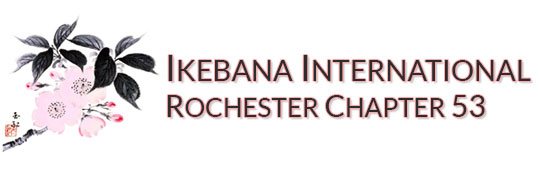
Unshin Ohara founded the Ohara School in the late nineteenth century, when Japan opened itself to the influence of Western culture. His departure from previous ikebana lay in the creation of a new form which he called the moribana style. This style later evolved into the school’s “landscape arrangement.” He also designed and produced the wide, shallow containers most suitable for works in the moribana style.
The above small arrangement is a “Near View Landscape” with Fritillary and Leucojum. It is called Near View, because it uses materials that grow at your feet as you look down while you walk through the garden.
The Second Headmaster, Koun Ohara, established moribana as a formal style, and promoted Ohara ikebana throughout Japan. The Third Headmaster, Houn Ohara, developed works with strong literary and pictorial connotations, creating the styles called Bunjin and Rimpa.
This second arrangement here is known as an “Upright Style” using one of the Ohara moribana containers. The arranger used flowers from their own garden. This arrangement has an uplifting feel to it and is one of the first arrangements that a new ikebana student learns.

The next arrangement is also called a moribana “Upright Style,” using different summer materials from the garden. This time the shallow container has a rectangular shape.


A flowering Cornelian cherry branch leans across the water in this “Water Reflecting Style” arrangement. The supermarket red roses are a counterpoint to the seasonal early Spring yellow of the Cornelian cherry and together give a sense of energy and vitality.
The arrangement below uses the same materials as the one above, but this time in a tall classical vase usually called a Heika. Even though the materials are the same, this arrangement has a different feel. It has a certain elegance for which vase arrangements are known.


The arrangement in a Margarita glass is called a “Radial Form” with its long side branches giving the sense of an expansive flow much like the summer sun. This type of arrangement looks good on a wide piece of furniture such as a buffet or a narrow entry hall table, a welcome sight for visitors. The flowers used for ikebana don’t have to be bought through florist shops, but can be everyday common materials like this purple callicarpa with zinnia and fresh green leaves from the artist’s garden.
The next small arrangement is called a “Free Expression” as it does not follow any particular rules or instructions regarding its creation. In “Free Expression” the arranger can respect the natural growth habit of the materials or can change the aspect of the plant material. Truus Roest, a Canadian potter in Montreal, made the container which holds spray carnations and one Xanadu leaf.

This last arrangement is also a “Free Expression.” It is not called a Free Style because an arrangement with a “Style” title implies fixed measurements and angles. Free Expression arrangements don’t have these restrictions. This arrangement was made during the winter. Ikebana arrangements usually reflect the present season or the next one. Even though this arrangement is not truly a seasonal arrangement, the evergreen material and the dried wood reflect the winter time of year.

